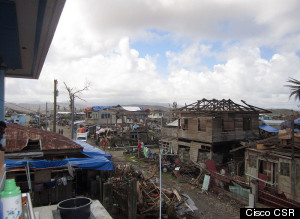It's no secret that technology is constantly changing how we live our everyday lives. From how we shop, manage our finances and stay connected to friends and family, it plays a vital role.
So it's no surprise that technology is also changing the way we respond when disaster strikes.
As we've seen most recently in the aftermath of Typhoon Haiyan, decision makers need immediate access to basic data in order to identify which areas need the most attention. As the typhoon struck the Philippines in early November 2013, the world was kept in the loop with near-instantaneous updates via live tweets, images and videos from the region.  But in order to provide disaster relief of any kind -- water, food, medicine -- we need to have access to reliable information about the situation in affected regions so we can actively provide support to those who are most in need. From field assessment and first response to recovery in a disaster zone, there is a basic need for technology and communications, both in and out of the affected areas.
But in order to provide disaster relief of any kind -- water, food, medicine -- we need to have access to reliable information about the situation in affected regions so we can actively provide support to those who are most in need. From field assessment and first response to recovery in a disaster zone, there is a basic need for technology and communications, both in and out of the affected areas.
So when news reports flood media during a crisis, people all around the world want to help but can't jump on a plane and head to ground zero. According to World Internet Stats, there are over 2.4 billion Internet users around the world. How do we leverage that number to help provide emergency response? What role can it play in enhancing relief efforts?
Some people choose to contribute to efforts by donating funds via websites or by SMS but, online operations like MicroMappers, Humanity Road, and Crisis Commons offer individuals opportunities to actively participate in the relief efforts from comfort of their homes. Coined "digital volunteers," people can now help sort, sift and source information related to the emergency that is floating around the web.
The day before Typhoon Haiyan made landfall, NetHope's partner, the U.N.'s Office for the Coordination of Humanitarian Affairs (OCHA), put out an urgent call to the Digital Humanitarian Network (DHN) to ask volunteers to sift through social media and help digitally map the impact in the Philippines. The Standby Volunteer Task Force (SBTF) responded to the appeal, jumpstarting a MicroMapper project dedicated to tagging reports to help OCHA assess the typhoon's damage. Images were tagged from 'mild' to 'severe' and then geolocated to create maps of the disaster damage.
According to the Standby Task Force, 120 volunteers participated in the Haiyan project and approximately 55,000 tweets were processed using MicroMappers; at the peak of their productivity, volunteers tagged around some 1,500 tweets in just 10 minutes.
By utilizing digital volunteers and crowdsourcing the seemingly mundane task of looking through images and social media posts at the onset of a crisis can expedite response organizations' assessments and allow them to be even quicker in rescue and response.
Without these information-age volunteers, the overflow of information during disasters would become as detrimental to a response effort as no information at all; these volunteers help make sense of it all. They also mitigate response costs, reducing the number of personnel needed in country for assessments.
Another technology being leveraged for assessment in disaster zones is unmanned aerial vehicles (UAVs), commonly referred to as civil drones. UAVs provide a bird's-eye view of a disaster zone, which can aid in assessing damage and roadblocks as well as help identify the best places to set up equipment, tents and field hospitals. They are also being tested with thermal cameras to help find people trapped underneath rubble.
Danoffice IT, a Danish-based company and one of NetHope's partners, deployed its Huginn X1 drone with a company expert to help NetHope member organizations and others responding to Typhoon Haiyan in the Philippines. The information retrieved from the aerial view allowed NetHope member Direct Relief and their partner Team Rubicon to gain invaluable awareness that kept safe their staff while assessing the complex local situation.
While nothing can completely replace boots-on-the-ground aid in these areas devastated by disaster, utilizing available technology and remote volunteers willing to contribute time and their digital skills can advance emergency response to be increasingly more efficient and effective.
For more information about NetHope's Emergency Response program visit: NetHope.org.
Cisco Systems has supported NetHope since its inception in 2001 with equipment, employee time, and expertise. For more information visit: http://nethope.org/supporters/.